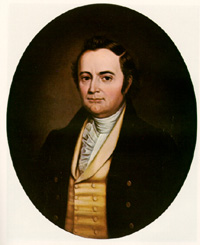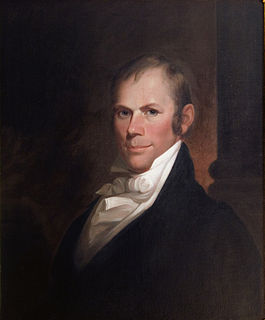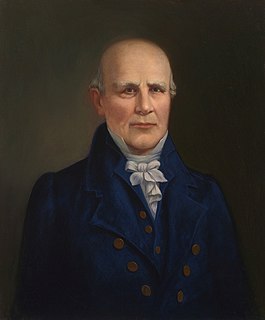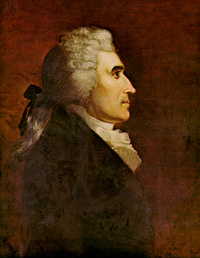
The Twelfth Amendment to the United States Constitution provides the procedure for electing the president and vice president. It replaced the procedure provided in Article II, Section 1, Clause 3, by which the Electoral College originally functioned. The amendment was proposed by the Congress on December 9, 1803, and was ratified by the requisite three-fourths of state legislatures on June 15, 1804. The new rules took effect for the 1804 presidential election and have governed all subsequent presidential elections.

The New Hampshire House of Representatives is the lower house in the New Hampshire General Court, the bicameral legislature of the state of New Hampshire. The House of Representatives consists of 400 members coming from 204 legislative districts across the state, created from divisions of the state's counties. On average, each legislator represents about 3,300 residents.

Elections to the United States House of Representatives for the 19th Congress were held at various dates in different states between July 1824 and August 1825, coinciding with the contentious 1824 Presidential election. After no Presidential candidate won an electoral majority, in February 1825 the House of the outgoing 18th Congress chose the President in a contingent election.

Elections to the United States House of Representatives for the 18th Congress were held at various dates in different states between July 1822 and August 1823 during President James Monroe's second term.

Elections to the United States House of Representatives for the 12th Congress were held at various dates in different states between April 1810 and August 1811 during President James Madison's first term.

Elections to the United States House of Representatives for the 8th Congress were held at various dates in each state, from April 26, 1802 to December 14, 1803 during Thomas Jefferson's first term in office. It was common in the early years of the United Congress for some states to elect representatives to a Congress after it had already convened. In the case of the 8th Congress, the representatives from New Jersey were only elected after its first meeting on October 17, 1803.

Elections to the United States House of Representatives for the 6th Congress took place in 1798 and 1799, the earliest in New York in April 1798, and the latest in Tennessee in August 1799, after the official start of the 6th Congress on March 4, 1799, but before the start of the first session of this Congress in Philadelphia on December 2, 1799. It was the last congressional session before the move to the new capital at Washington, D.C..

Elections to the United States House of Representatives for the 5th Congress took place in the various states took place between August 12, 1796, and October 15, 1797. The first session was convened on May 15, 1797, at the proclamation of the new President of the United States, John Adams. Since Kentucky and Tennessee had not yet voted, they were unrepresented until the second session.

Elections to the United States House of Representatives for the 4th Congress were held on various dates in each state between August 25, 1794, and September 5, 1795 (Kentucky). The election was held during President George Washington's second term.

Elections to the United States House of Representatives for the 3rd Congress were held in 1792 and 1793, coinciding with the re-election of George Washington as President. While Washington ran for president as an independent, his followers formed the nation's first organized political party, the Federalist Party, whose members and sympathizers are identified as pro-Administration on this page. In response, followers of Thomas Jefferson and James Madison created the opposition Democratic-Republican Party, who are identified as anti-Administration on this page. The Federalists promoted urbanization, industrialization, mercantilism, centralized government, and a broad interpretation of the United States Constitution. In contrast, Democratic-Republicans supported the ideal of an agrarian republic made up of self-sufficient farmers and small, localized governments with limited power.

Elections to the United States House of Representatives for the 1st Congress were held in 1788 and 1789, coinciding with the election of George Washington as first President of the United States. The dates and methods of election were set by the states. Actual political parties did not yet exist, but new members of Congress were informally categorized as either "pro-Administration" or "anti-Administration".

Elections in the U.S. state of New Hampshire are held at national, state and local level. The state holds the first presidential primary in the national cycle. Elections for a range of state positions coincide with biennial elections for the House of Representatives.
Multiple non-transferable vote (MNTV), also known as plurality-at-large voting or block vote, is a non-proportional voting system for electing several representatives from a single multi-member electoral district using a series of check boxes and tallying votes similar to a plurality election. Multiple winners are elected simultaneously to serve the district. Block voting is not a system for obtaining proportional representation; instead the usual result is that where the candidates divide into definitive parties the most popular party in the district sees its full slate of candidates elected, resulting in a landslide.
Both houses of the United States Congress have refused to seat new members based on Article I, Section 5 of the United States Constitution which states that:
"Each House shall be the judge of the elections, returns and qualifications of its own members, and a majority of each shall constitute a quorum to do business; but a smaller number may adjourn from day to day, and may be authorized to compel the attendance of absent members, in such manner, and under such penalties as each House may provide."
The United States Senate elections of 1796 and 1797 were elections for the United States Senate which, coinciding with John Adams's election as President, had the ruling Federalist Party gain one seat.

Three of the four New Hampshire incumbents were re-elected.

New Hampshire elected its members August 26, 1822. New Hampshire law required a candidate to receive votes from a majority of voters for election, that is 1/12 of votes. Only five candidates received the requisite majority, and so a May 11, 1823 run-off election was held for the sixth seat.

New Hampshire law required a candidate to receive votes from a majority of voters (10%). In the August 27, 1810 initial election, only two candidates won a majority, so a second election was held April 1, 1811 for the remaining three seats, after the congressional term began but before the Congress formally convened. The data from the source used give majorities to all the top five candidates, suggesting that the data are incomplete.

New Hampshire elected its members between November 1, 1824 and March 8, 1825. New Hampshire law required candidates to receive votes from a majority of voters for election. As only five candidates received votes from a majority of voters, a run-off election had to be held for the sixth seat on March 8, 1825.

The 2020 United States House of Representatives elections in New Hampshire was held on November 3, 2020, to elect the two U.S. Representatives from the state of New Hampshire, one from each of the state's two congressional districts. The elections coincided with the 2020 U.S. presidential election, as well as other elections to the House of Representatives, elections to the United States Senate and various state and local elections.









